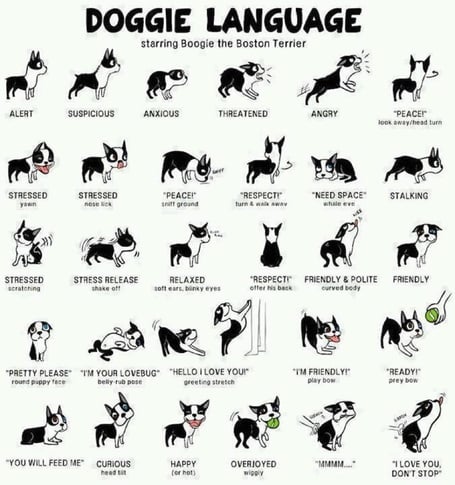I am sure you are aware that your dogs have their own unique body language that enables them to provide information to other dogs and hopefully to their humans. Sometimes it can be quite subtle and sometimes it’s quite full on! Getting to know a dog’s body language is really important as it can tell us so much about how a dog is feeling, whether it is happy, unsure, frightened, feeling threatened, joyful. When I was younger, I was oblivious to my first dogs’ body language, which is testament to her for being so wonderful with my ignorance! Now, I hope that my dogs are thankful that I do (mostly)know what they are communicating to me I am still learning, and my dogs continue to be great teachers.
I have included a visual with a breakdown of a dogs’ body language, you may see things that your dog does and be surprised or pleased that you now know what it means when your dog raises a paw or rolls over. Remember that when you look at your dogs’ body language you have to look at the whole picture, so what are the ears, eyes, tail, body communicating to you. Is the dog in a relaxed posture, or are they panting or wide eyed? We also need to think about the environment, this is a key part in providing information as to why your dog might be behaving in a certain way, for example, a loose dog approaching, loud traffic noise, or a child getting too close.
One important feature of a dogs’ body is its tail, and a tail wag doesn’t always mean its feeling friendly! The height of the tail, the intensity and speed of the wag and also the extra information coming from the dogs’ body gives a clear indication as to what the dog is feeling. We have to also remember that some breeds have tails that are permanently curled like Pugs or Huskies so this can confuse issues a little. It is advisable to get used to your dogs’ relaxed tail position so that you know when they are feeling relaxed or tense and unhappy.
As a general rule if a dog is holding its tail mid height and is wagging it in a relaxed manner with broad strokes, it is feeling happy. If the tail is mid height but the tail wag is shorter, quicker strokes, then the dog is feeling unsure and possibly anxious. This dog might not appreciate too much fuss or being approached. If the tail is held high and there are quick short wags it means the dog is alert and probably very excited about something! (Think terrier that has seen a squirrel) If a dog holds its’ tail upright and the tail is stiff, then we need to give this dog some space, as it could mean its not feeling at all friendly and could go into attack mode. A tail that is quite stiff and slightly wagging but held low, almost under the dog’s body, will mean anxiety and offering appeasing signals to whoever is approaching. Again, remember that the tail is only one part of the dog’s body, so look at what the ears are doing too, are they back, forward or neutral? Is the body relaxed, tense, or low to the ground? Are the eyes relaxed or wide and exposing the white? All these important body signals are a dogs’ way of communicating how it is feeling emotionally.
As I have learnt over the years, reading how your dog is communicating with its’ body is so helpful in knowing when it needs space, or feels unsure or wants to say hello to another dog, or not.
I hope you enjoy the visual, I have a bigger version in my training cabin and it’s a great reference tool.

.jpeg?width=209&height=140&crop=209:145,smart&quality=75)



Comments
This article has no comments yet. Be the first to leave a comment.